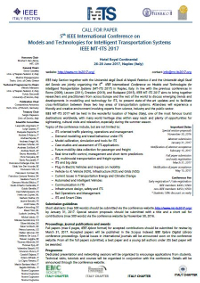SPECIAL SESSION
Chiara Fiori
Sustainable Mobility
The European Union has set an ambitious target for reducing its greenhouse gas (GHG) emissions and aims for an 80% reduction in 2050 compared to 1990 levels. The reduction target for the transport sector is 60% over the same period (EC, White paper 2011).
The transportation sector is the second-largest source of greenhouse gas emissions, and it is responsible for 34% of the total CO2 emissions. In 2014 it accounted for approximately one third (27%) of the total world primary energy consumption (U.S. EIA, 2014). These days, personal mobility is de facto powered only by petroleum. Specifically, in 2014 petroleum accounted for 92% of the total transportation energy consumption (U.S. EIA, 2012). Moreover, within the transport sector, road freight transport is one of the fastest growing modes of transport and has an increasing share in the total GHG emissions of transport. Over the last decade, road freight transport emissions grew by around 25% in EU 27 (EEA, 2011), without significant changes to vehicle fuel consumption.
A solution to make the mobility system sustainable and to not impact the future generation is needed.
Plug-in Electric Vehicles (PEVs) represent a technical solution that meet the requirements of the European Union for the following reasons:
1. Improve vehicle fuel economy and reduce petroleum consumption. PEVs are characterized by higher efficiency in the vehicle powertrain. This is allowed by the presence of electric devices characterized by a very high efficiency (more than 90%).
2. Improve air quality in urban areas. PEVs represent one of the promising technologies that can guarantee, locally, zero CO2 emissions.
3. Achieve CO2-free city logistics: Electric Freight Vehicles (EFVs) represent a possible solution to obtain zero emissions in the last mile delivery, and thus possibly satisfying the EU requirement of CO2-free city logistics in major urban centers by 2030.
4. The electricity can be provided by several electric charging methods, such as: (i) conductive charging, (ii) inductive (i.e. wireless) charging, (iii) battery swaps, and (iv) via overhead catenary wires.
5. Electricity can be generated on-board by a hydrogen fuel cell.
6. Promote fuel diversity and integration of renewable sources. It is important that the electricity powering PEVs is produced from renewable sources, to obtain near-zero emissions through the full energy pathway.
In conclusion, a cross fertilization among experts in innovative automotive systems and in transportation systems is needed. Topics related to this session are the following:
• Impact of PEVs to the Electric Power Infrastructure
• Eco-routing strategies for PEVs
• PEVs and Eco-driving
• Integration of Renewable Energy and Hydrogen Systems in the charging infrastructure for innovative powertrains
• Integration of PEVs in Smart Grids and Smart Cities
• Hydrogen and vehicle electrification: future trends
• EFVs: energy consumption, eco-routing and eco-driving strategies, impact to electric power infrastructure and integration with renewable energy




